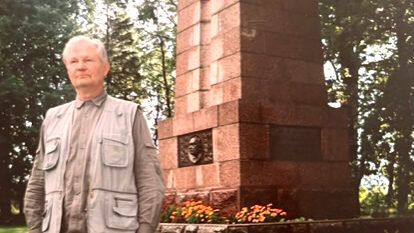Therefore it was obvious that politicians who lent their enthusiastic support to the Black Ribbon Day cause did so out of a genuine commitment to the movement's goal – Peace Through Freedom. Their support simply could not be translated into striving to gain more potential voters to guarantee their success in the next election. That math simply didn't add up.
It was obvious right from the start of the Black Ribbon Day activities in 1986 that the movement was not only an effort in educating the public about the equal culpability of the Soviet Union and Nazi Germany. The movement also helped to remind us that one regime was no longer a threat to freedom and liberty, and while acknowledging the liberalization process in the USSR, the other had still managed to fully retain its totalitarian characteristics with a menacing self-confidence.
Even currently (2014) revisionist analysis of the MRP has become an issue in the Russian establishment. They insist that Soviet repression has been deliberately exaggerated by the West: “Attempts to compare or equate Hitler's regime with the USSR destroy the single historical focal point – our victory in the war.”
Russia steadfastly maintains that the MRP was a strategic necessity, primarily driven by needs for self-defence. It still categorically rejects the notion that Soviet co-operation with the Third Reich was a factor for the ensuing human devastation in Europe. It's obvious that the present (2014) government and media in Russia have moved back somewhat to the Soviet position, using the political expletive “falsifiers of history”, asserting that the Nazi German and Soviet Russian invasions of Poland in 1939, soon after striking the MRP agreement were unconnected to the pact.
The Gulag and its millions of victims was not a new target of protest to Westerners. But the Black Ribbon Day network gave concerned individuals a renewed determination to try to make a change. The fate of numerous imprisoned freedom fighters in the Soviet Union and elsewhere in the Warsaw Pact became more compelling to people in the West.
While the number of cities participating in the 1986 Black Ribbon Day activities was 21, it had grown to 36 in 1987 including Vilnius. The MRP efforts also reached Tallinn and Riga in 1987. By 1988 these demonstrations were not disallowed by Soviet authorities. It was then inevitable that the 50th anniversary of the MRP in 1989 would get a special initiative in the Baltic states.
Thus a human chain was proposed to mark the anniversary of the notorious MRP. Just as the Black Ribbon Day idea had caught the imagination of thousands worldwide, the human chain proposal motivated hundreds of thousands to participate in 1989. The chain was mapped out by organizers, designating specific locations to specific towns, villages and, cities so that the chain would be uninterrupted. Free buses were provided for demonstrators to reach designated locations. The preparation effort energized previously uninvolved people. Radio broadcasts helped coordinate the event. Estonia declared a national holiday so that employers couldn't prevent people from attending.
The Baltic peoples issued a joint declaration to the world clearly stating their aspirations. The international media made it their top story. Never had there been a human chain of over one million people stretching through three countries attempted before. The will of the people was undeniable.
The Black Ribbon Day organizers refused to be drawn into the debate about which regime did the greatest damage to humankind. If sheer numbers of victims were to be the deciding criteria, then one could argue that Communism, in this case specifically Soviet communism would overwhelmingly have wielded the most deadly attack on humanity. To become embroiled in a numbers game would have defeated the ultimate purpose of the Black Ribbon Day movement – that there were regimes worldwide in which brutality, oppression, the choking of the human spirit were the controlling mechanisms of governance. A non-violent, peaceful solution to alleviate, to remove these conditions had to be found.
The Black Ribbon Day efforts brought into a clear focus the most inhuman aspects of Soviet totalitarianism: That regime made a crime of advocating for representative democracy. It did not allow any discussion of political reform in order to protect incompetent, violent, criminal dictatorships. It destroyed any notion of the rule of law and an independent judiciary. It pursued the persecution of faith communities. It turned culture and art into regulated, sterile propaganda. It forced hard working farmers through the threat of deportation into collectives. It removed all rights of unions. It used organized starvation as a weapon against untrustworthy nationalities. It systematically deported members of ethnic groups to remove any possibility of an opposition in any locality.
The Black Ribbon Day organization and movement achieved more public awareness and greater participation than any other similar efforts in the past. In North America the equivalent would be the Captive Nations groups and activities in different localities, something that deserves our wholehearted praise for its staunch and enduring annual actions.
The Black Ribbon Day took a cue from the Captive Nations concept and drew global attention to its cause, achieved solidarity among central and eastern European organizations joined by the other suffering nationalities such as Vietnamese, Afganistans (Soviet control in 1980s), Cubans etc. It was an emotionally captivating experience. But more than this the Black Ribbon made thousands aware that it was simply wrong to remain either complacent or over-confident.
Laas Leivat




